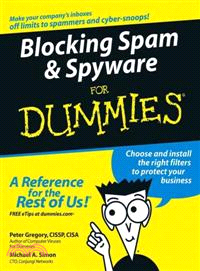| FindBook |
有 1 項符合
BLOCKING SPAM &SPYWARE FOR DUMMIES的圖書 |
 |
BLOCKING SPAM &SPYWARE FOR DUMMIES 作者:PETER H. GREGORY 出版社:DUMMIES BOOK REGISTRATION 出版日期:2005-04-08 |
| 圖書館借閱 |
| 國家圖書館 | 全國圖書書目資訊網 | 國立公共資訊圖書館 | 電子書服務平台 | MetaCat 跨館整合查詢 |
| 臺北市立圖書館 | 新北市立圖書館 | 基隆市公共圖書館 | 桃園市立圖書館 | 新竹縣公共圖書館 |
| 苗栗縣立圖書館 | 臺中市立圖書館 | 彰化縣公共圖書館 | 南投縣文化局 | 雲林縣公共圖書館 |
| 嘉義縣圖書館 | 臺南市立圖書館 | 高雄市立圖書館 | 屏東縣公共圖書館 | 宜蘭縣公共圖書館 |
| 花蓮縣文化局 | 臺東縣文化處 |
|
|
- 圖書簡介
Fight back and save money with these expert tips
Find out what spam and spyware cost your company, and how to stop them
Whether yours is a one-person business or a multi-million dollar corporation, here's help giving spammers and spies the bum's rush. Two veterans of the spam wars help you analyze your situation, choose the right solutions, set up and maintain them, and even show the bean-counters why such defenses are essential.
Discover how to
* Understand how spammers get addresses
* Calculate the cost of spam and spyware
* Re-engineer your business processes
* Select spam and spyware filters
* Manage implementation and maintenance - 作者簡介
Peter Gregory, CISA, CISSP, is a career IT guy who has worn just about every hat that could be worn in the Data Processing/Information Systems/Information Technology business. Peter has IT experience in government, banking, nonprofit, legalized gambling, and telecommunications. The Usenet-E-mail-Internet bug bit him in the mid 1980s. He has spent the past eleven years in two wireless telecom companies, working in positions where he develops security policy, security architecture, and security emergency response teams, and is a security consultant in general.
His passion for computers is matched only by his dedication to helping people know how to use information systems — from personal computers to mainframes — more effectively and safely. He achieves this through his speaking appearances at security conferences, in ComputerWorld and other online publications, and through a security consulting company that he cofounded in 2002.
Michael A. Simon works as a computer security consultant in the Seattle area and the northwestern U.S. with clients in banking, e-commerce, health care, and biotechnology. Mike has been working in IT security for around 20 years and wrote his first programs on punched cards for an IBM mainframe in the early 1980s. Although he doesn’t get much chance to exercise his skills in COBOL or Fortran these days, he keeps a deck of blank IBM punch cards around just in case.
For the last 10 years, Mike has been working for the company that he cofounded with Corwin Low when the Internet was more innocent, and convincing people of security’s importance was a difficult task. Mike keeps busy assessing new threats for his clients, lecturing at Seattle University and the University of Washington, and advancing the public service goals of Northwest Security Institute, a non-profit that he helped to found. - 目次
Introduction.
Part I: Understanding the Problem.
Chapter 1: Spam and Spyware: The Rampant Menace.
Chapter 2: The Spyware Who Loved Me: Stopping Spyware in Its Tracks.
Chapter 3: Understanding the Enemy: What Really Spawns Spam.
Part II: Justifying and Selecting Spam and Spyware Filters.
Chapter 4: Calculating ROI for Your Anti-Spam and Anti-Spyware Measures.
Chapter 5: Developing the Battle Plans.
Chapter 6: Evaluating Anti-Spam and Anti-Spyware Solutions.
Part III: Deploying Your Chosen Solution.
Chapter 7: Training Users and Support Staff.
Chapter 8: Planning the Rollout.
Chapter 9: Rolling Out to the Enterprise.
Chapter 10: Supporting Users.
Part IV: Maintaining Your Defenses.
Chapter 11: Everyday Maintenance.
Chapter 12: Handling Thorny Issues.
Chapter 13: Defense in Depth: Providing Layers of Protection.1
Part V: The Part of Tens.
Chapter 14: Ten Spam-Filtering Solutions for the Enterprise.
Chapter 15: Ten Keys to Successful Spam Filtering.9
Chapter 16: Ten Spam-Related Issues Most Enterprises Face.
Chapter 17: Ten Spyware-Filtering Solutions for Businesses.
Chapter 18: Ten Online Resources for Resolving Spam and Spyware.
Chapter 19: Ten Keys to Successful Spyware Filtering.
Appendix A: Spam and Spyware Filtering Project Plan.
Appendix B: Spam and Spyware Filtering Project Requirements.
Appendix C: Glossary.
Index.
|










